During the Card-E era, namely between Expedition Base Set in 2002 and EX Team Magma vs Team Aqua in 2004, a lot more than simply the card’s Pokédex info was packed into the the Dot Code bars on the bottom of every card. Now when you scan the bottom Dot Code bar in an e-Reader device, you generally got two main Viewer pages: the Pokémon page and the Card page. Regardless of which generation of cards you scanned in—Gen 2/Wizards of the Coast or Gen 3/Nintendo—the Card page came with a little extra data: Dictionary keyword links which contain more info about various Pokémon TCG aspects. And this page aims to cover them all!
Now to be specific, the Card page on every card has Dictionary links to various TCG keywords, which are all colored red to denote that they can be selected and clicked on. However, the amount of available keywords—as well as where you can find them—changes between the generation of releases. You can see what I mean below:
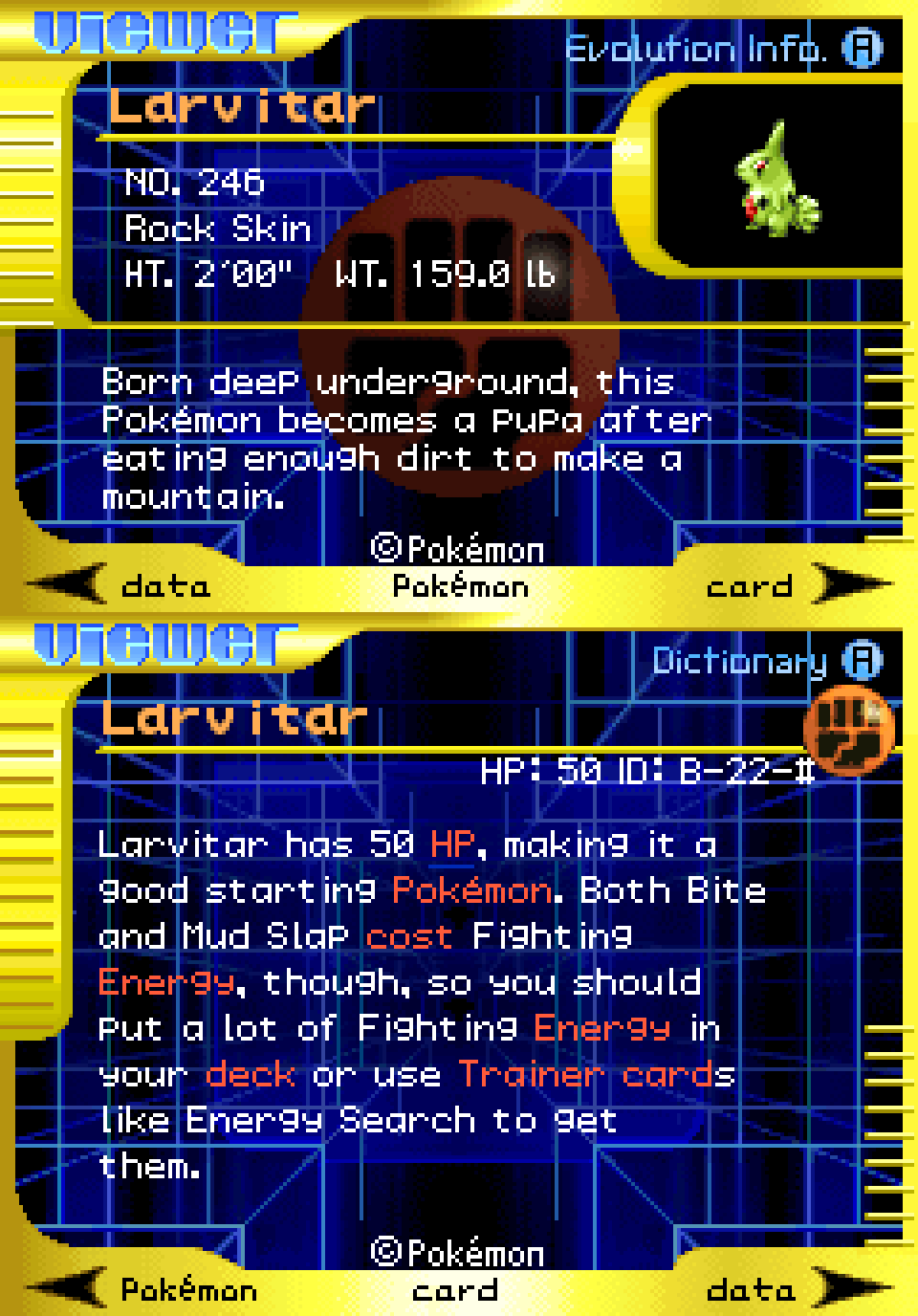
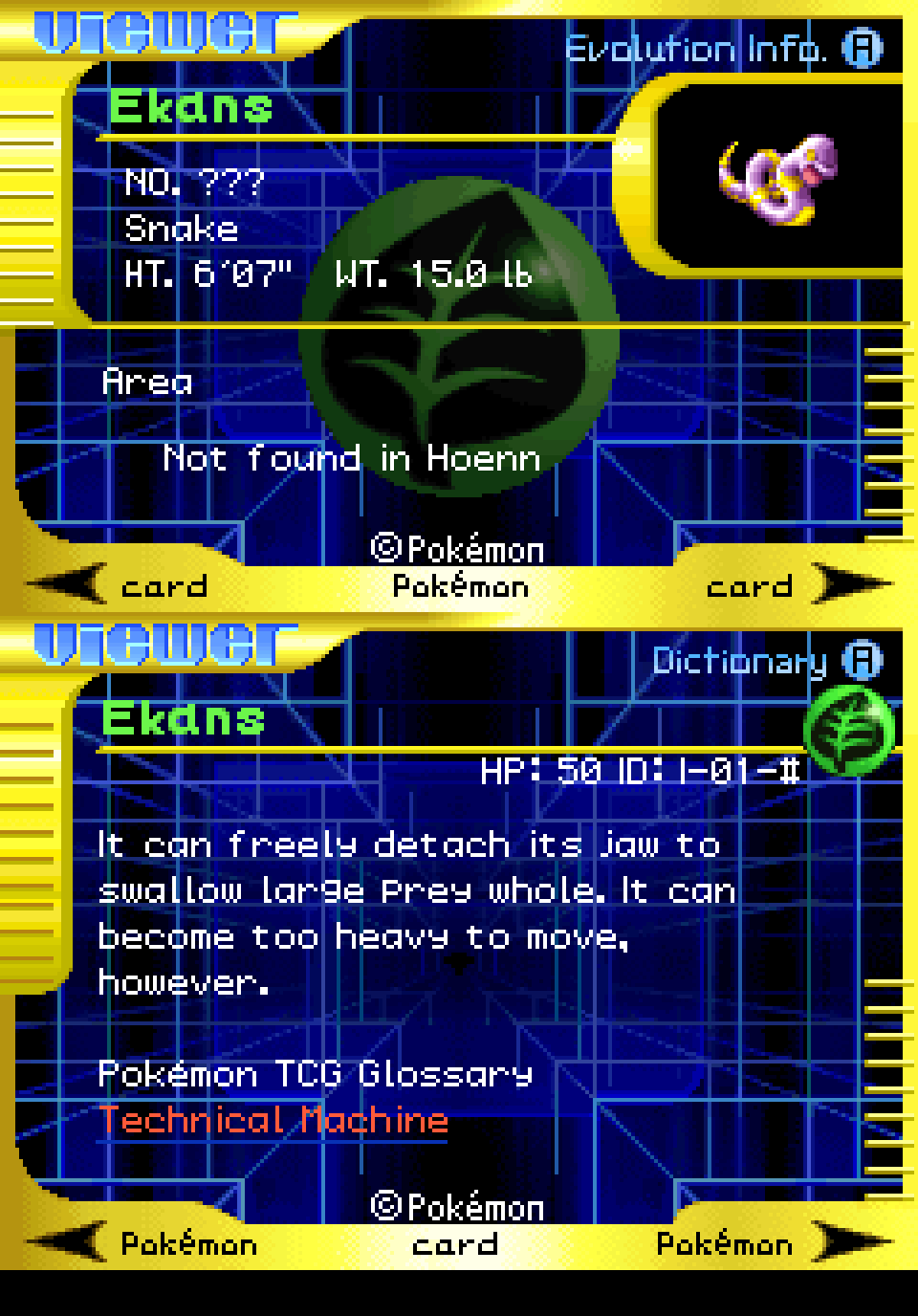
- Gen 2/Wizards of the Coast (left): the Card page contains various protips on how to best utilize that card in your game, and so Dictionary links are scattered throughout the entire entry
- Gen 3/Nintendo (right): the Card page contains the Pokédex flavor text entry for that Pokémon, finishing off with a single randomly chosen “Pokémon TCG Glossary” entry
As you scroll through the Card page, you can press UP or DOWN on the D-Pad to select any number of TCG terms, which is underlined by a glowing blue bar. You can then press the A button to load the TCG term you selected, which loads the Dictionary page for that entry:
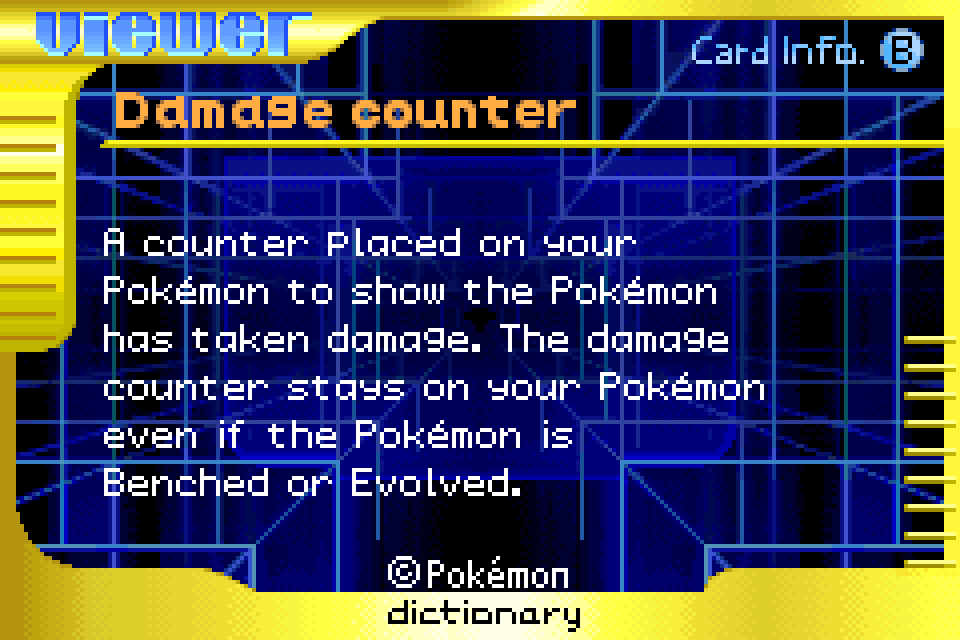
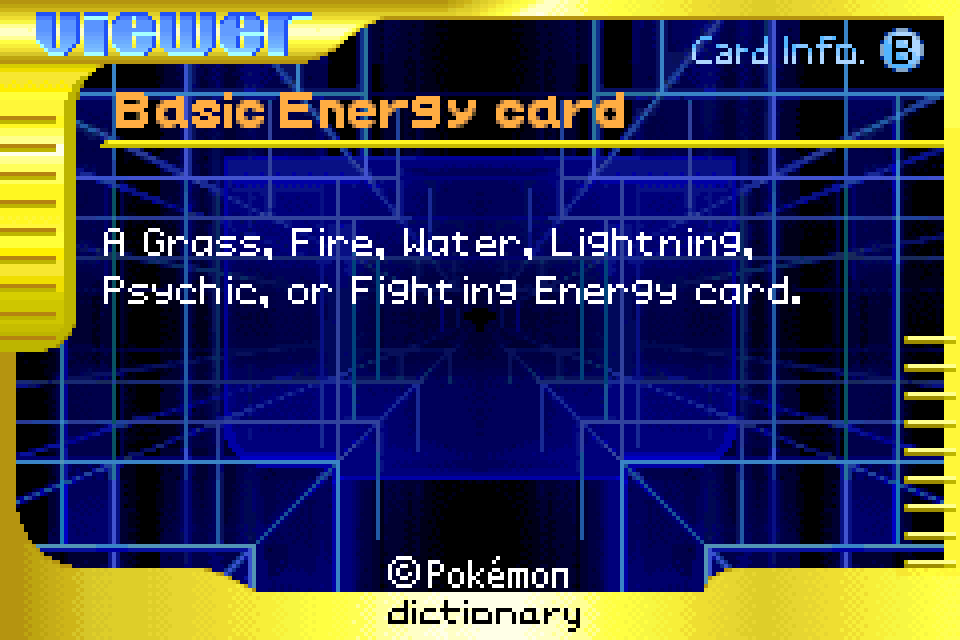
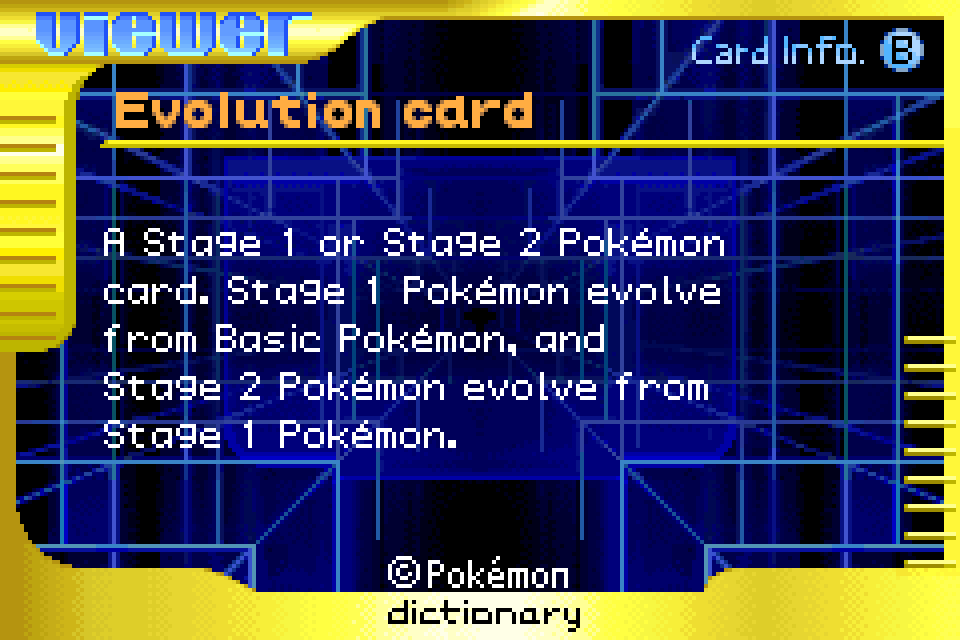
When you’re done, you can simply press the B button to return to the Card page. Fairly straight-forward stuff, right?
BTW, there’s one last info I need to point out: it turns that 20-plus years worth of changes to the Pokémon TCG means that all of the below info might be somewhat out-of-date. For example, recently Nintendo/TPC updated some of the ruling concerning the keywords “Defending Pokémon” and “Opponent’s Active Pokémon”… so while for the longest time (and particularly during the Card-E era) those two phrases were effectively one-in-the-same, it was later changed to mean that “Defending Pokémon” is any Pokémon that is being attacked—whether that Pokémon is in the Active position or on the Bench—while “Opponent’s Active Pokémon” means literally just that. In a way it makes a bit of sense, but this just means that those 20-plus years of minor ruling and phrase updates have made the following Dictionary of TCG words and phrases a bit out of sync with the game as it is.
Therefore… this collection of Dictionary entries is being provided for the sake of historical posterity—a snapshot of what the game was like once upon a time—and not as a currently valid collection of modern tournament ruling and TCG definitions.
With that said, this page aims to collect every Dictionary entry on the cards, as well as link to whichever card uses them. The reverse will be true, where the e-Reader Entries page will have links to the specific Dictionary entry just as it would when you scan that card on an actual e-Reader accessory. This page will also keep track of any different versions of the Dictionary entries, such as if they varied between the Wizards and Nintendo eras.
OK, without further ado, here are the TCG Dictionary entries!
Active/Defending Pokémon
The Pokémon you send out to fight. When it’s your turn, it’s called your Active Pokémon, while your opponent’s Active Pokémon is called the Defending Pokémon. Only your Active Pokémon can attack.
Asleep
A Special Condition Pokémon can have. Turn a Pokémon sideways to show it is Asleep. As long as a Pokémon is Asleep, it can’t attack or retreat. After each player’s turn, flip a coin. On a coin flip of heads, the Pokémon wakes up. The Pokémon is no longer Asleep when it returns to the Bench.
Attack
1) When your Active Pokémon fights your opponent’s Pokémon.
2) The text written on each Pokémon card that shows what it does when it attacks (a Pokémon can have 1, 2, or 3 attacks on it).
Baby Pokémon
A Special type of card that you play directly from your hand. Baby Pokémon can evolve into other Pokémon. For example, if Pichu evolves into Pikachu, that Pikachu is an Evolved Pokémon, not a Basic Pokémon card. When a Baby Pokémon is your Active Pokémon and your opponent wants to attack it, he or she must flip a coin. If tails, the attack does nothing.
Basic Energy card
A Grass, Fire, Water, Lightning, Psychic, or Fighting Energy card.
Basic Pokémon card
A card that you can play directly from your hand.
Bench
Where your Pokémon wait before becoming your Active Pokémon.
Benched Pokémon
The Bench is an area where up to 5 Pokémon can wait before becoming your Active Pokémon. Benched Pokémon can’t attack or become Asleep, Confused, Paralyzed, Poisoned, or Burned. When a Pokémon under such Special conditions retreats to the Bench, these effects are removed from it.
Between turns
When the status of Active Pokémon is updated. If a Pokémon is Poisoned, for example, it takes damage between turns.
Burned
A Special Condition Pokémon can have. A Pokémon can get Vurned from certain attacks. A Burn marker is placed on the Pokémon to indicate that it is Burned. A Burned Pokémon takes 20 damage on a coin flip of tails after each turn. The Burned effect is removed when the Pokémon retreats to the Bench.
Coin flip
An action required by many attacks and by instructions on Trainer and other cards. Such actions require you to flip a coin for heads or tails.
Confused
A Special Condition Pokémon can have. Turn a Confused Pokémon with its head pointed towards you to show that it is Confused. If a Pokémon is Confused, you have to flip a coin whenever you try to attack with that Pokémon or whenever you try to make it retreat. When you try to retreat a Confused Pokémon, you first have to pay the Retreat Cost by discarding Energy cards from the Pokémon and then flip a coin. On heads, you retreat the Pokémon normally. On tails, the retreat fails, and that Pokémon can’t try to retreat again that turn. When you attack with a Confused Pokémon, you flip a coin. The attack works on heads, but on tails, your Pokémon attacks itself with an attack that does 20 damage (if your Pokémon has Weakness or Resistance to its own type, or if there is some other effect that would alter the attack, apply these things as usual).
Damage
A number on most attacks. You put that many damage counters on the Defending Pokémon and subtract 10 from the Defending Pokémon’s Hit Points for each damage counter. A Pokémon is Knocked Out if it has at least as much damage as Hit Points.
Damage counter
A counter placed on your Pokémon to show the Pokémon has taken damage. The damage counter stays on your Pokémon even if the Pokémon is Benched or Evolved.
Deck (general)
The cards you use to play. A deck has 60 cards (30 in some cases). To play the Pokémon® Trading Card Game, you build a deck from your collection of cards or play straight from a deck box you can buy at the store.
Deck (in play)
A pile of cards from which you draw cards into your hand. Each player begins his or her turn by drawing a card from his or her deck.
Devolution
The process of removing Evolution cards from a Pokémon. Such effects as Sleep, Confusion, Paralysis, Poison, and Burn (not damage) are removed when a Pokémon devolves. If the number of damage counters on a devolved Pokémon are equal to or greater than its Hit Points, it gets Knocked Out.
Discard pile
The pile of cards you have discarded. These cards are always placed face up. Anyone can look at these cards at any time.
Does nothing
What happens to an attack when it fails. An attack can do nothing for a number of reasons. Once your attack does nothing, you must end your turn.
Effects
The end results of attacks, activated Pokémon Powers (Poké-Power and Poké-Body), Trainer cards, and Energy cards.
Energy
Pokémon need Energy to attack or retreat. You give your Pokémon Energy by attaching Energy cards to them.
Energy card
A type of card that powers your Pokémon and makes them able to attack. Unless otherwise noted, you are entitled to attack 1 Energy card to your Pokémon each turn.
Energy Cost
The amount and type of Energy that you need to have attached to a Pokémon in order to have it use a given attack.
Evolution
The process of evolving one of your Basic Pokémon by putting an Evolution card on it. Such effects as Sleep, Confusion, Paralysis, Poison, and Burn (not damage) are removed when a Pokémon evolves.
Evolution card
A Stage 1 or Stage 2 Pokémon card. Stage 1 Pokémon evolve from Basic Pokémon, and Stage 2 Pokémon evolve from Stage 1 Pokémon.
Evolved Pokémon
Pokémon that come into play through evolution. When a Basic Pokémon card is played on top of a Baby Pokémon, that Basic Pokémon is also treated as an Evolved Pokémon.
Hand
A set of cards that both players draw from their decks. They draw 7 at the beginning of the game, but the number of cards in each player’s hand changes throughout the game. At any point of the game, you can ask your opponent how many cards he or she has in his or her hand, and your opponent had to tell you.
Hit Points(HP)
A number every Pokémon has, telling you how much damage it can take before it is Knocked Out.
Knocked Out
What a Pokémon is when it has damage greater than or equal to its Hit Points. That Pokémon goes to the discard pile, along with any cards attached to it. When one of your opponent’s Pokémon is Knocked Out, you take 1 of your Prizes.
Marker
A counter that shows that a Pokémon is Poisoned, Burned, or under another effect like that. These markers are removed when the Pokémon is evolved or devolved.
Multicolor deck
A deck that is built with more than 1 type of Energy. For example, you can build a deck with a mixture of Water and Fighting Energy.
Paralyzed
A Special Condition Pokémon can have. If a Pokémon is Paralyzed, it can’t attack or retreat. Turn the Pokémon sideways to show that it is Paralyzed. If an Active Pokémon is Paralyzed, it recovers after its player’s next turn. Turn the card right-side up again. The Pokémon is no longer Paralyzed when it returns to the Bench.
Poisoned
A Special Condition Pokémon can have. A Poison marker is placed on a Pokémon to indicate that it is Poisoned. A Poisoned Pokémon takes 10 damage after each player’s turn. The Pokémon is no longer Poisoned when it retreats to the Bench.
Poké-Body
A special ability some Pokémon have that is activated automatically.
Poké-Power
A special ability that some Pokémon have. Poké-Powers are in the same place on cards as attacks are, but they always have the word “Poké-Power” in front of them so you can tell they’re not attacks.
Pokémon
The colorful creatures that fight for you in the Pokémon® Trading Card Game. They are represented in the game by Baby Pokémon, Basic Pokémon, and Evolution cards.
Pokémon Tool
A type of Trainer card. You attach it to a Pokémon that doesn’t have a Pokémon Tool attached to it.
Promo card
A card that’s not sold at a store. You get promo cards for free, but only at special times, like when you play in the Pokémon® Trading Card Game League.
Remaining HP
The Hit Points a Pokémon has left when you take away 10 for each damage counter it has. That’s how close the Pokémon is to being Knocked Out.
Resistance
A trait Pokémon can have. Resistance is indicated by a type symbol and “-30” in the bottom center of a Basic Pokémon or Evolution card. You get to subtract 30 from the damage your Pokémon receives if your Pokémon has Resistance to the attacking Pokémon.
Retreat
When you take your Active Pokémon and switch it with one of your Benched Pokémon. To retreat a Pokémon, you must discard an amount of Energy from it equal to the Pokémon’s Retreat Cost. When a Pokémon is Asleep or Paralyzed, it can’t retreat. The Retreat Cost appears in the lower right-hand corner of the card.
Special Conditions
Special effects of some attacks on the Defending Pokémon. These include Asleep, Confused, Paralyzed, Poisoned, and Burned. These effects happen only to the Defending Pokémon and not Benched Pokémon. A Pokémon can also make itself become Asleep, Confused, Paralyzed, and Burned. When a Pokémon that is Asleep, Confused, Paralyzed, Poisoned, or Burned retreats to the Bench, these effects are removed from it.
Special Energy card
An Energy card–like Darkness, Metal, or Rainbow–that has a special effect.
Stadium card
A type of trainer card. When a Stadium card is played, it stays in play until another Stadium card comes into play. When a Stadium card is in play, you are not allowed to play a Stadium card of the same name.
Sudden Death
The tiebreaker. Each player uses only 1 Prize instead of the usual 6 (3 in some cases).
Supporter card
A type of Trainer card that you play during your turn and discard at the end of your turn. You can have only one Supporter card in play at a time (you can still play other kinds of Trainer cards).
Technical Machine
A type of Trainer card that you play during your turn and discard at the end of your turn. A Pokémon with a Technical Machine card attached to it can use the attack written on the card.
Trainer card
A card that you play during your turn by following its instructions and then discarding it. There are several kinds of Trainer cards, including Supporters, Pokémon Tool, and Stadium cards.
Type/color
One of the colors of Energy and Pokémon. There are 9 types–Grass, Fire, Water, Lightning, Psychic, Fighting, Darkness, Metal, and Colorless.
Weakness
A trait of Pokémon can have. If a Pokémon has Weakness, it takes double damage when attacked by Pokémon of the type it has a Weakness to. Weakness is indicated in the lower left-hand corner of the card.
Anyways, this is still a work in progress, so things are still a bit chaotic in design. Once I get more Dictionary entries added, I’ll start sorting through and organizing everything. In fact, I’ve already got a couple ideas I’d like to add to this list:
- Count dictonary entries by Gens
- Specifically, I’ll be counting how often a particular Dictonary entry appears on a Gen 2 or Gen 3 card.
- For the sake of not double-counting certain entries, I’ll only be counting the number of cards that reference it. For example, Lapras (F-17) references “Supporter cards” and “Weakness” twice each, and “Pokémon” thrice… but I’ll just consider that those terms were seen on a single card each: Lapras.
- The end goal here is to see how often a particular Dictionary definition appears, if there was maybe a more rare entry relative to others, and if maybe a particular entry was changed between Gens or doesn’t appear until a Gen 3 card due to a rule change upon the release of the EX sets. Or maybe Gen 3 cards ignored a particular entry for some reason. Now I’m not expecting anything special or crazy here… but who knows?
- Organize entries by categories; I’m thinking of categories like:
- Card types: Baby Pokémon, Trainer cards, Energy card, etc
- Card functions: HP, Weakness, Resistance, Attack, etc
- Special Conditions: Asleep, Confused, Paralyzed, etc
- Gameplay areas: Bench, Deck, Hand, etc
- Misc terms: Type/color, Coin flip, Marker, etc
This’ll probably be in the next update I make to this page, at least once I’m convinced I’ve pretty much got every possible Dictionary entry added and accounted for.
But yeah, pretty informative stuff, huh? At least you don’t need to scan any cards to read the entries. It’s kinda interesting to see how things have changed over the years, but also how much has stayed the same. Ahh, history.
